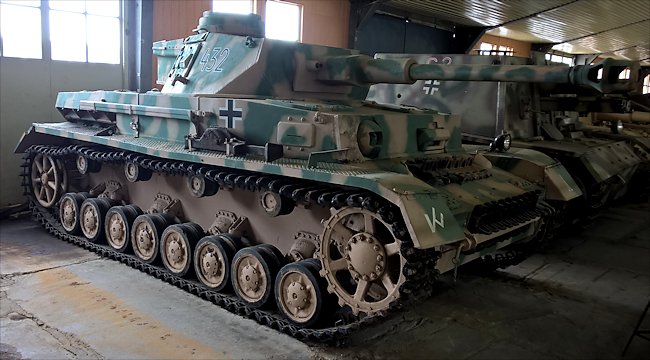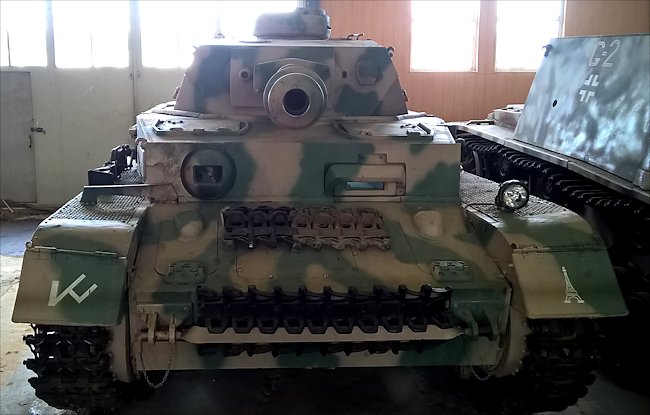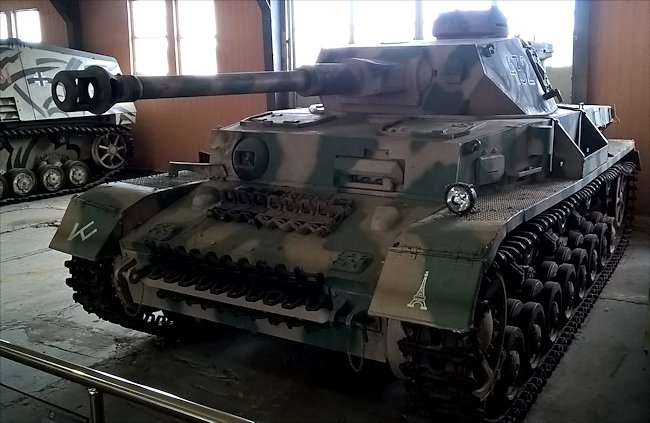Pz.Kpfw Panzer IV Tank Ausf. G
This German Panzerkampfwagen Panzer IV tank Ausfuhrung G can be found at the Kubinka Tank Museum in Russia just an hour outside Moscow by Train.

German Panzer IV Tank Ausf G with the upgraded long barreled 75mm gun Kubinka Tank Museum in Russia
Location
Take the train from Moscow's Belorusskaya Railway Station, in the north west of the city, to Kubinka. It is about an hours train journey. It is a direct service, no need to change, and the the tickets are cheap. Make sure you print off a list of station names so you can check off where you are and get ready to get off the train at Kubinka. The station names are not always easy to read or see.
Although this military town has been active for over 80 years it has a rundown look to it. You can walk to the museum but there is the equivalent of a motorway crossing your route. There are no pedestrian crossings over it. There are a number of taxi stands near the station. They are very cheap and honest. I tried to give the driver a big tip but he refused. Ask for his card so you can ask the Museum gate staff to call his company when you are finished at the Museum to get back to the railway station.
Development
During World War Two this tank belonged to 23rd Panzer Division, 201 Panzer Regiment, it was produced in 1942 and knocked-out in January 1943, recovered and later repaired. It was used as a training vehicle until 1945. On the original tank, there were no German unit markings, except the crosses. The paint and camo scheme approximately correspond to the original ones.
Under the driver's viewing device, from internal side the Fahrgestell chassis number 82937 was found. On the front side of the hull under the Bow machine gun Mount the hull chassis number 83293 was uncovered. On the centre of the turret roof the turret number 82993 was obtained. This Panzer IV tank was built by Krupp.

German Panzer IV Tank Ausf G with the upgraded long barreled 75mm gun Kubinka Tank Museum in Russia
The German invasion of Russia
In addition to up-gunning tanks and the infantry anti-tank gun, the Germans radically changed the composition of their panzer divisions while increasing the number of self-propelled assault guns available to infantry formations.
After September 1940 each panzer division would have only one panzer regiment (either of two or three tank battalions) and two infantry regiments (each of two motorized battalions) plus a motor cycle battalion, the usual reconnaissance unit, artillery and engineers. Though regretted by some, the reduced Armoured fighting Vehicle AFV content did assist with handling, quite apart from doubling the tally of panzer divisions and increasing the number of mechanized infantry units.
The Russians were also in process of transition. In the aftermath of their misleading experience in the Spanish Civil War they had tended to create smaller infantry support and reconnaissance units, but were now reverting to tank corps. Each corps would consist of Tank Divisions and Mechanized Rifle Divisions, the former with two tank and one motorized infantry regiments, the latter with one tank and two motorized infantry regiments.

German Panzer IV Tank Ausf G with the upgraded logn barreled 75mm gun Kubinka Tank Museum in Russia
This vast reshuffle coincided with a program of re-equipping. The obsolete Vickers-derived heavy T 28 and light T- 26, and the Christie-type BT light tanks, were gradually being replaced by vastly superior heavy KV-I and medium T 34/76s. So much change at once not only overloaded the apparatus organization, but, at a time when many of the most experienced officers had been purged, killed on Stalin's orders as he feared a revolt against his leadership.
This brought decay in standards and training fell to such a low ebb that unit tank strengths were often lower than 35 per cent fit for action. Thus the Russian strength of some 17000 AFVs was far more apparent than real. Communications equipment was poor and command and control systems rudimentary and unpracticed. Most Soviet tank commanders used signaling flags as the other tanks in their unit did not have radios fitted.
Large as was the German invading force which entered Russia on 22 June, 1941 it could not cover every mile of territory conquered. Wide gaps always opened between the fast mechanized columns spearheading the mass of marching cavalry and infantry, spaces which had to be patrolled by aircraft and ground reconnaissance troops when seeking enemy concentrations and providing warning of hostile reactions.
But as had been the case in Western Europe, in the desert and in the Balkans, the sheer speed and coordinated dash of the German onslaught completely overwhelmed and stunned opposition which, numerically, was greater. Although forewarned of the enemy menace, Josef Stalin, as supreme Soviet commander, refused, until it was too late, to permit an alert.
Indeed, there is current speculation that Stalin was on the eve of launching a spoiling attack of his own against the Germans. Be that as it may, the surprised Soviet army and air force were knocked off balance at the outset, and found it impossible to recover their equilibrium before immense damage was inflicted upon them.
So far as the armored struggle was concerned, the Germans with over 5000 tanks had overall superiority. The panzer IIIs and IVs were technically better in every respect than the T28s, T26s and BTs and were able by splendid coordination of all arms to out-match enemy formations which rarely concentrated fully or managed to work as part of a team.
Many Russian tanks were swept up in the initial rush having fired hardly a shot. Those which a few days later appeared in hastily assembled brigade groups were invariably massacred, or cut off and deprived of fuel until they surrendered or were abandoned.
The overrunning of the Russian Baltic Front by General Hoeppner's 4th Panzer Group; of the Central Front by General Hoth's 3rd and General Guderian's 2nd Panzer Groups; and of the Southern Front by General von Kleist's 1st Panzer Group were operations of a similar pattern — a series of all-embracing encirclements which consumed entire armies within the first month's campaigning.
Take the operations of Hoth and Guderian as examples: by 29 June the large garrison at Brest Litovsk had been obliterated, six divisions netted at Bialystock, six more at Volkovsk and a further fifteen bagged in the Novogrudok pocket, when the pincers of the two panzer groups closed at Minsk after advancing against opposition some 200 miles or more in a single week. Numerous tank- versus-tank actions there were, but almost always ending in a German victory.
Key to the early German success was, as usual, excellent radio control while the Russian control was cither erratic or totally non-existent below battalion or company level. Brain power defeated brute strength and ignorance: it was as basic as that!
WW2 tank books

